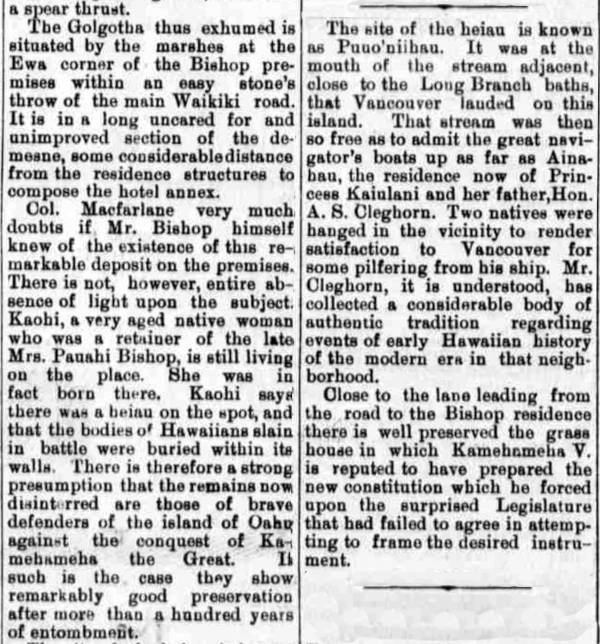Haunted Royal Hawaiian Center, Helumoa
Haunted Royal Hawaiian Center, Helumoa
Waikiki the former seat of Hawaiian Royalty
Since the time of the O‘ahu Ali‘i, Mā‘ilikūkahi, in the 1400s, Waikiki has been the home of royalty and Oahu’s center of government. In the 1600s, during the time of Ali‘i Kakuhihewa, a sixth-generation descendant of Ma‘ilikukahi, as the story is told, there was a champion fighting rooster that lived in Ka‘au, a large crater in the Palolo district, high above Waikiki. This was no ordinary rooster, however. People said this rooster was a supernatural being of half-man/half-chicken. The rooster’s name is often referred to as “Ka‘auhelemoa” or “Ka‘auhelumoa.”
One day, Ka‘auhelumoa flew down from his home and landed in Waikiki. Furiously scratching the earth, he caught the attention of Kakuhihewa, and then suddenly vanished. Kakuhihewa took this as an omen and planted niu, coconuts, where the rooster was digging.
Coconut trees were incredibly important to Hawaiians due to their versatility and abundance. Used for food, drink, and materials for building, the niu appears in numerous legends. The water in a young coconut was even used for special blessings and ceremonies.
From Kakuhihewa’s initial planting, it is said that more than 10,000 coconut trees grew.
Kamehameha I and his warriors camped here when they landed in 1795, ready to fight for Oahu. He later made his home here for a time before moving the royal seat to Pakaka in Kou, now known as Honolulu. In the 1880s, Kamehameha’s great-granddaughter, Bernice Pauahi Bishop inherited Helumoa. Upon her death in 1884, the land was bequeathed to Bishop Estate.
Golgotha at Waikiki
More than 200 years later, in March 1898, Colonel George Macfarlane leased some space in Waikiki to establish a seaside annex to Downtown Honolulu’s “Hawaiian Hotel.” This space was Helumoa, that huge grove of coconut trees.
Japanese laborers were hired to level off some mounds in this same coconut grove. In preparation for removing some of the coconut trees, they cut off the roots around the tree, and then they went to lunch.
As they were returning from their break, a gale rattled the foliage of the tall palms like castanets. The undermined trees shivered in the blast of wind and began to reel. Upon their fall, even the ground rumbled and, it is stated, the awa and mullet in an adjacent pond leaped clear out of the water.
As the workmen retreated from the falling trees, the unthinkable happened. Flung high into the air by the catapultic motion of the roots was a mass of human bones - entire skulls, femurs, vertebrae, ribs, everything. One skull struck one of the workers in the back as he ran, and when he turned to see what hit him, he almost died of fear!
There was no way to get the men back to work. The only one who returned was the foreman. He began delving in the soil when, close to the surface, he found an entire skeleton. It was in a sitting position with arms extended over the head. There was another skeleton discovered not so well united in frame.
A very aged woman named Kaohi, who was a retainer for Princess Pauahi was still living near the place. She said she was born there and there used to be a heiau on that spot. The bodies of Hawaiians slain in battle were buried within its walls.
As You Explore Waikiki and Haunted Honolulu
You’ll find the hidden past beneath Honolulu’s busy streets. The discovery of human bones beneath the Royal Hawaiian Center is a chilling reminder that even in the heart of Waikīkī, haunted Honolulu is never far away. Some believe these remains are tied to ancient burials—disrupted resting places that have stirred restless spirits. Others whisper that the site lies near a pathway once used by the night marchers, ghostly warriors who appear when the sacred is disturbed.
This location is one of many haunted places in Waikīkī where the past refuses to stay buried. From Waikīkī to downtown, our Waikīkī ghost tours reveal stories hidden beneath the surface—legends, sightings, and encounters that define the most haunted places in Hawaii.





